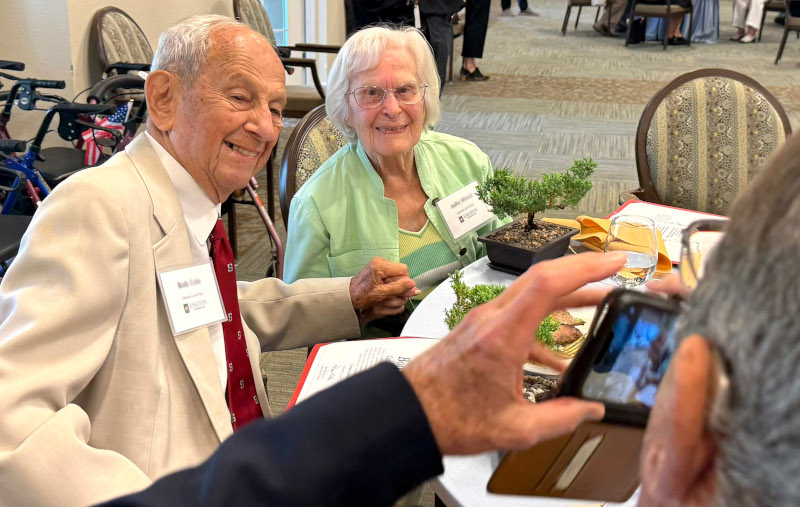By Lola Rain
I overheard one centenarian say to the other: “I know why I’m here, do you know why you are?”
If I were a philosopher, I might have thought: “To be or not to be … that is the question.” But in that moment, surrounded by a room full of people who have lived a full century, the literal question she may have been asking her centenarian friend was: How did you make it to 100?
During an Eskaton centenarian celebration, I wandered the room speaking with the honorees, asking them about their secrets to longevity. This wasn’t my first time celebrating centenarians. Over the years, I’ve taken them on vintage airplane rides and joined in birthday parties filled with children, grandchildren, great-grandchildren — sometimes even great-great-grandchildren.
Each time I walk away struck by how these events push us to see aging differently. While some 100-year-olds need wheelchairs and walkers, others move like they’re in their 70s. Age and decline do not go hand-in-hand. But age and resilience do.
Talking to Eskaton residents, I heard, “I always eat my vegetables,” “I stay active,” “I read every day,” “I listen to music,” “I keep busy.” This reminded me of what we’ve learned through Dan Buettner’s book The Blue Zones and his Netflix series Live to 100: Secrets of the Blue Zones. Longevity science is real.

Bob Cole’s son snaps a photo of Bob, 103, with his friend Julia at Eskaton’s centenarian celebration in Carmichael, California, on September 19, 2025. Bob said appreciating family is his secret to longevity.
Remy Gross, of the Buck Institute for Research on Aging, presented to the room of 30 centenarians along with their families and Eskaton staff and board members. He offered proven methods to extend our healthspan. Remy stressed that a sedentary lifestyle is far worse than smoking.
Here is a synopsis of his presentation, which will explore the difference between lifespan and healthspan.

Centenarians honored at Eskaton Village Carmichael, September 19, 2025.
Why Centenarian Celebrations Matter
Eskaton isn’t alone in recognizing its residents’ milestones. American House Senior Living recently announced the Longevity League, a program to celebrate centenarian residents. Meanwhile, governors in Utah and Montana have stepped up to honor centenarians with luncheons and proclamations, placing longevity on the public stage. These celebrations remind us that longevity is still a big achievement, even as more and more people crest over 100, joining the 101,000+ centenarians in the U.S. (2024 Pew Research)
Staff are Guardians of Legacy
For the people who work in senior living, these celebrations are meaningful. They connect staff to the deeper purpose of their work: honoring lives, not just providing care. Celebrating centenarians builds pride, boosts morale, and helps staff see themselves as part of something more than their daily duties.
Power of Storytelling
Jack York, chief storyteller and founder of Talegate, is a champion of longevity. His Vintage Voices 100 van tour across the U.S. grew out of a passion for capturing stories. For Jack, Vintage Voices is both a tribute and a reminder: people want to be heard and have their stories told. Jack points out that this doesn’t happen by accident. It requires intention from staff and leadership. Over the past few years, Jack has recorded nearly 150 conversations that took place in his Chrysler Voyager, documenting the resilience, humor, and wisdom of each centenarian. Jack shares these stories at events across the nation.
Secret to Longevity
Centenarian celebrations are about more than birthdays. They are about recognizing the people who experienced a century of what life threw at them — all the happy, sad, joyful, frustrating, exhilarating, and priceless moments.
The next time you overhear two older people talking, lean in and learn from their journey. You might find they possess the real secret to longevity.







